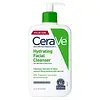What's inside
What's inside
 Key Ingredients
Key Ingredients

 Benefits
Benefits

 Concerns
Concerns

 Ingredients Side-by-side
Ingredients Side-by-side

Water
Skin ConditioningGlycerin
HumectantCetearyl Alcohol
EmollientPEG-40 Stearate
EmulsifyingStearyl Alcohol
EmollientPotassium Phosphate
BufferingCeramide NP
Skin ConditioningCeramide AP
Skin ConditioningCeramide EOP
Skin ConditioningCarbomer
Emulsion StabilisingGlyceryl Stearate
EmollientBehentrimonium Methosulfate
Sodium Lauroyl Lactylate
EmulsifyingSodium Hyaluronate
HumectantCholesterol
EmollientPhenoxyethanol
PreservativeDisodium EDTA
Dipotassium Phosphate
BufferingTocopherol
AntioxidantPhytosphingosine
Skin ConditioningXanthan Gum
EmulsifyingCetyl Alcohol
EmollientPolysorbate 20
EmulsifyingEthylhexylglycerin
Skin ConditioningWater, Glycerin, Cetearyl Alcohol, PEG-40 Stearate, Stearyl Alcohol, Potassium Phosphate, Ceramide NP, Ceramide AP, Ceramide EOP, Carbomer, Glyceryl Stearate, Behentrimonium Methosulfate, Sodium Lauroyl Lactylate, Sodium Hyaluronate, Cholesterol, Phenoxyethanol, Disodium EDTA, Dipotassium Phosphate, Tocopherol, Phytosphingosine, Xanthan Gum, Cetyl Alcohol, Polysorbate 20, Ethylhexylglycerin
Water
Skin ConditioningGlycerin
HumectantDecyl Glucoside
CleansingSodium Methyl Cocoyl Taurate
CleansingTaurine
BufferingSodium Cocoyl Apple Amino Acids
Skin ConditioningPhenoxyethanol
PreservativeCocamidopropyl Hydroxysultaine
CleansingSodium Cocoyl Glycinate
CleansingArginine
MaskingCitric Acid
BufferingSodium Chloride
MaskingHexylene Glycol
EmulsifyingBisabolol
MaskingLactobacillus/Pumpkin Ferment Extract
Skin ConditioningSaccharide Isomerate
HumectantEthylhexylglycerin
Skin ConditioningTocopheryl Acetate
AntioxidantSodium Lauroyl Lactylate
EmulsifyingCoconut Acid
CleansingGlycine
BufferingTetrasodium Glutamate Diacetate
Sodium Ascorbyl Phosphate
AntioxidantBromelain
Skin ConditioningLactobacillus Ferment
Skin ConditioningSodium Citrate
BufferingMaltodextrin
AbsorbentZingiber Officinale Root Extract
MaskingWater, Glycerin, Decyl Glucoside, Sodium Methyl Cocoyl Taurate, Taurine, Sodium Cocoyl Apple Amino Acids, Phenoxyethanol, Cocamidopropyl Hydroxysultaine, Sodium Cocoyl Glycinate, Arginine, Citric Acid, Sodium Chloride, Hexylene Glycol, Bisabolol, Lactobacillus/Pumpkin Ferment Extract, Saccharide Isomerate, Ethylhexylglycerin, Tocopheryl Acetate, Sodium Lauroyl Lactylate, Coconut Acid, Glycine, Tetrasodium Glutamate Diacetate, Sodium Ascorbyl Phosphate, Bromelain, Lactobacillus Ferment, Sodium Citrate, Maltodextrin, Zingiber Officinale Root Extract
 Reviews
Reviews

Ingredients Explained
These ingredients are found in both products.
Ingredients higher up in an ingredient list are typically present in a larger amount.
Ethylhexylglycerin (we can't pronounce this either) is commonly used as a preservative and skin softener. It is derived from glyceryl.
You might see Ethylhexylglycerin often paired with other preservatives such as phenoxyethanol. Ethylhexylglycerin has been found to increase the effectiveness of these other preservatives.
Glycerin is already naturally found in your skin. It helps moisturize and protect your skin.
A study from 2016 found glycerin to be more effective as a humectant than AHAs and hyaluronic acid.
As a humectant, it helps the skin stay hydrated by pulling moisture to your skin. The low molecular weight of glycerin allows it to pull moisture into the deeper layers of your skin.
Hydrated skin improves your skin barrier; Your skin barrier helps protect against irritants and bacteria.
Glycerin has also been found to have antimicrobial and antiviral properties. Due to these properties, glycerin is often used in wound and burn treatments.
In cosmetics, glycerin is usually derived from plants such as soybean or palm. However, it can also be sourced from animals, such as tallow or animal fat.
This ingredient is organic, colorless, odorless, and non-toxic.
Glycerin is the name for this ingredient in American English. British English uses Glycerol/Glycerine.
Learn more about GlycerinPhenoxyethanol is a preservative that has germicide, antimicrobial, and aromatic properties. Studies show that phenoxyethanol can prevent microbial growth. By itself, it has a scent that is similar to that of a rose.
It's often used in formulations along with Caprylyl Glycol to preserve the shelf life of products.
Sodium Lauroyl Lactylate is the lauric acid sodium salt of lactyl lactate.
Sodium Lauroyl Lactylate is an emulsifier and surfactant.
Emulsifiers help stabilize a product. They do this by preventing ingredients from separating, such as oils and water which do not mix naturally. Surfactants reduce surface tension, making it easier to rinse pollutants off skin.
Due to its relation to lauric acid, it may provide antimicrobial benefits.
Learn more about Sodium Lauroyl LactylateWater. It's the most common cosmetic ingredient of all. You'll usually see it at the top of ingredient lists, meaning that it makes up the largest part of the product.
So why is it so popular? Water most often acts as a solvent - this means that it helps dissolve other ingredients into the formulation.
You'll also recognize water as that liquid we all need to stay alive. If you see this, drink a glass of water. Stay hydrated!
Learn more about Water